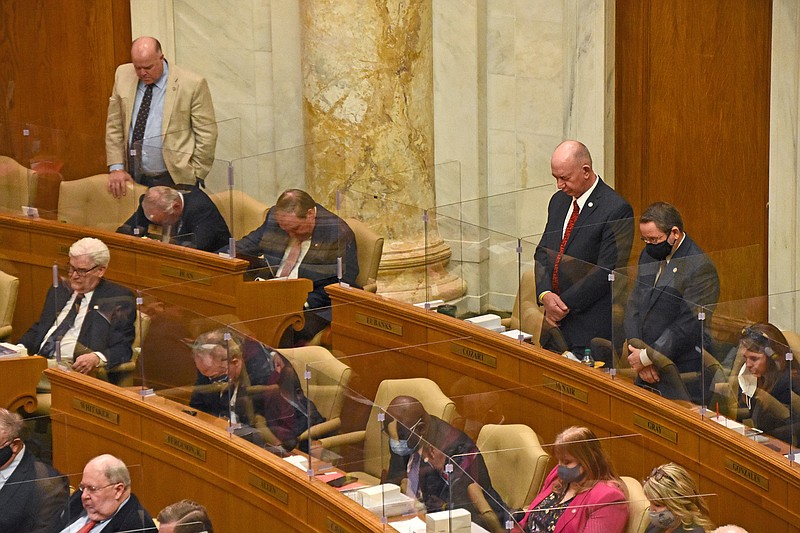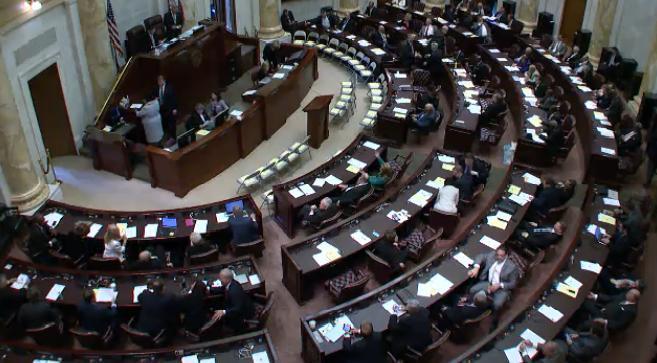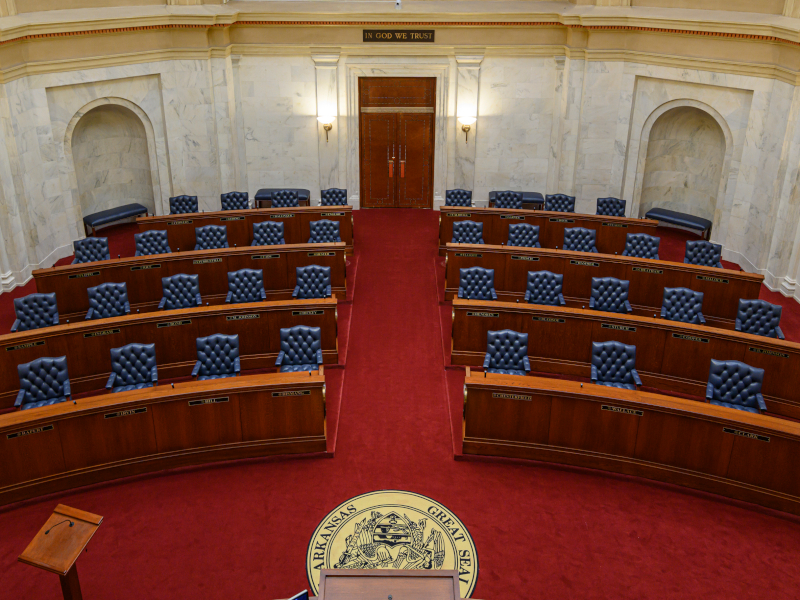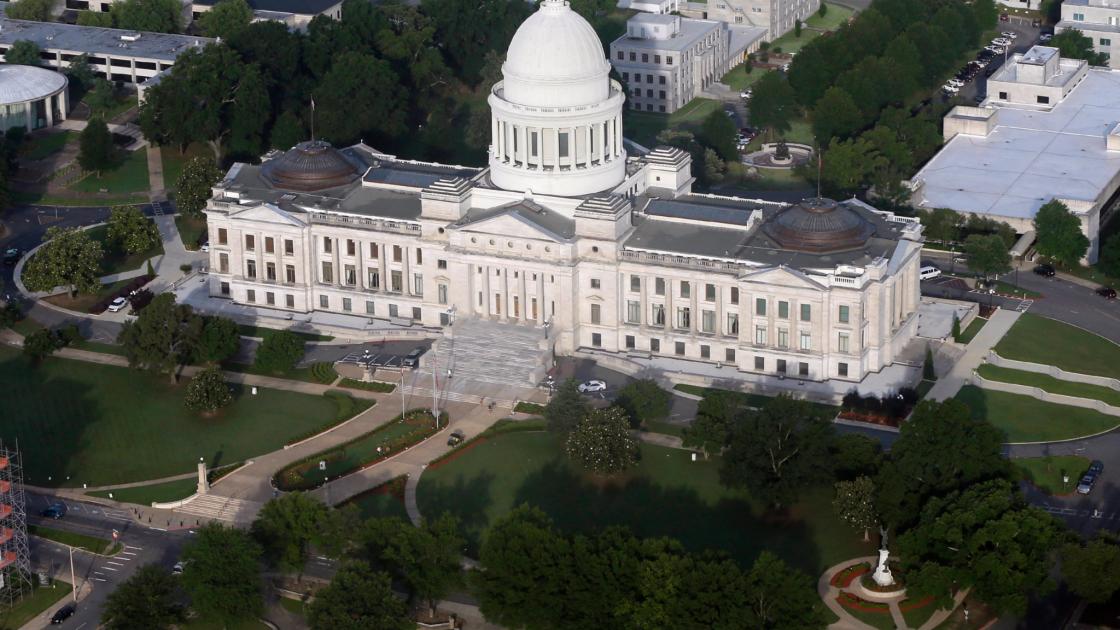Summary
The Arkansas General Assembly is the state legislature of the U.S. state of Arkansas. The legislature is a bicameral body composed of the upper house Arkansas Senate with 35 members, and the lower Arkansas House of Representatives with 100 members. All 135 representatives and state senators represent an equal number of constituent districts.
The General Assembly convenes on the second Monday of every other year. A session lasts for 60 days unless the legislature votes to extend it. The Governor of Arkansas can issue a “call” for a special session during the interims between regular sessions. The General Assembly meets at the Arkansas State Capitol in Little Rock.
Source: Wikipedia
OnAir Post: AR General Assembly
News
Legislative leaders said they expect to call the state House of Representatives and Senate back into the extended regular session, starting Sept. 29, to consider legislation to redraw the state’s four congressional district boundaries based on the 2020 U.S. Census data.
Senate President Pro Tempore Jimmy Hickey, R-Texarkana, and House Speaker Matthew Shepherd, R-El Dorado, last week provided lawmakers with a timeline for considering the redistricting legislation.
Hickey said Tuesday that there is no consensus in the Senate on how to redraw the boundaries and he’s hoping for a fairly concrete plan “before we come back into session.”
He said he is anticipating and hoping that the extended session meets three days and then the Legislature adjourns its regular session.
State lawmakers met for 108 days earlier this year before going into an extended recess with plans to return this fall to approve new boundaries for the congressional districts. The session started Jan. 11 and it was slowed by precautions taken for the coronavirus pandemic and a week’s break after a severe snowfall. The fall meeting was set because census data was delayed in its delivery to states.
“Leadership encourages congressional redistricting bills be filed no later than September, 24, 2021, for consideration during the extended session of the 93rd General Assembly,” according to Hickey and Shepherd’s two-page timeline.
Arkansas’ revenue has outpaced expectations for the month of May, while the state’s budget surplus has risen to its highest level.
The state’s net available general revenue for the month of May totaled just over $655 million, nearly an 80% jump over this time last year and about $263 million above forecast.
The latest report from the state Department of Finance and Administration shows results were above forecast in all major categories. A change in the tax deadline caused growth in individual income tax revenue, while revenues from other tax categories like tobacco and gaming also came in above forecast.
About
Source: Wikipedia
History
The Arkansas General Assembly is authorized by the Arkansas Constitution, which is the state’s fifth constitution. The first was constitution was ratified on January 30, 1836, and the current constitution was adopted in 1874.[1] The constitution has also been amended throughout the state’s history since 1874.[1]
Originally, legislators met biennially, but today meet annually.[2]
In 1922, Frances Hunt became the first woman elected to a seat in the Arkansas General Assembly when she was elected to a seat in the Arkansas House of Representatives.[3]
Powers and process
The Arkansas General Assembly is responsible for making and amending the laws of Arkansas. The legislative process is similar to that of other state legislatures in the United States. Bills undergo committee review and three readings on the floor of each house of the legislature. The governor has veto power, but a simple majority of both houses of the legislature can override that veto.[4]
Legislators also select 20 state representatives and 16 state senators to serve on the Arkansas Legislative Council, which oversees the Bureau of Legislative Research and acts as an organizing committee for the legislature.[2]
Terms and term limits
Amendment 73 of the Arkansas Constitution, approved by voters in the 1992 state general elections, set term limits for Representatives and Senators. Representatives were limited to three two-year terms (six years); Senators were limited to two four-year terms (eight years).
Amendment 73 also set term limits for U.S. Senators and Representatives, but this part of the Amendment was found unconstitutional by the United States Supreme Court in U.S. Term Limits, Inc. v. Thornton. As Section 4 of the Amendment included a severability clause, the remainder of the amendment remained in force.
This was replaced to a large extent by Amendment 94 in 2014, which extended the total years that could be served to 16 in any combination of House and Senate seats.
The law was changed again in 2020 by a referendum removing the lifetime limit of 16 years in the legislature and switching to 12 consecutive years with the option to return after a four year break.
See also
References
- Arkansas General Assembly, Encyclopedia of Arkansas History and Culture (accessed April 28, 2013)
- Arkansas Legislative Council, Encyclopedia of Arkansas History and Culture (accessed April 28, 2013)
- “Women”. The Encyclopedia of Arkansas History & Culture. Arkansas: The Central Arkansas Library System. 2010. Retrieved March 31, 2010.
- http://www.nga.org/files/live/sites/NGA/files/pdf/BOSTable3.16.pdf
External links
Wikipedia
Contents
The General Assembly of Arkansas is the state legislature of the U.S. state of Arkansas. The legislature is a bicameral body composed of the upper house Arkansas Senate with 35 members, and the lower Arkansas House of Representatives with 100 members. All 135 representatives and state senators represent an equal number of constituent districts.
The General Assembly convenes on the second Monday of every year. In odd-numbered years it may consider any bill or resolution; in even-numbered years it may only consider appropriations bills.[1] A session lasts for 60 days unless the legislature votes to extend it. The governor of Arkansas can issue a “call” for a special session during the interims between regular sessions. The General Assembly meets at the Arkansas State Capitol in Little Rock.
History
The General Assembly of Arkansas is authorized by the Arkansas Constitution, which is the state’s fifth constitution. The first constitution was ratified on January 30, 1836, and the current constitution was adopted in 1874.[2] The constitution has also been amended throughout the state’s history since 1874.[2]
Originally, legislators met biennially, but today meet annually.[3] In 1922, Frances Hunt became the first woman elected to a seat in the General Assembly when she was elected to the Arkansas House of Representatives.[4]
Powers and process
The General Assembly of Arkansas is responsible making and amending the laws of Arkansas. The legislative process is similar to that of other state legislatures in the United States. Bills undergo committee review and three readings on the floor of each house of the legislature. The governor has veto power, but a simple majority of both houses of the legislature can override that veto.[5]
Legislators also select 20 state representatives and 16 state senators to serve on the Arkansas Legislative Council, which oversees the Bureau of Legislative Research and acts as an organizing committee for the legislature.[3]
Terms and term limits
Amendment 73 of the Arkansas Constitution, approved by voters in the 1992 state general elections, set term limits for representatives and senators. representatives were limited to three two-year terms (six years); senators were limited to two four-year terms (eight years).
Amendment 73 also set term limits for U.S. senators and representatives, but this part of the Amendment was found unconstitutional by the United States Supreme Court in U.S. Term Limits, Inc. v. Thornton. As Section 4 of the Amendment included a severability clause, the remainder of the amendment remained in force.
This was replaced to a large extent by Amendment 94 in 2014, which extended the total years that could be served to 16 in any combination of House and Senate seats.
The law was changed again in 2020 by a referendum removing the lifetime limit of 16 years in the legislature and switching to 12 consecutive years, with the option to return after a four-year break.
See also
- Arkansas House of Representatives
- Arkansas Senate
- List of Arkansas General Assemblies
- State of Arkansas
References
- ^ Arkansas Constitution, Article 5, Section 5, Justia (accessed September 11, 2024)
- ^ a b Arkansas General Assembly, Encyclopedia of Arkansas History and Culture (accessed April 28, 2013)
- ^ a b Arkansas Legislative Council, Encyclopedia of Arkansas History and Culture (accessed April 28, 2013)
- ^ “Women”. The Encyclopedia of Arkansas History & Culture. Arkansas: The Central Arkansas Library System. 2010. Retrieved March 31, 2010.
- ^ “Archived copy” (PDF). Archived from the original (PDF) on August 13, 2016. Retrieved January 20, 2016.
{{cite web}}: CS1 maint: archived copy as title (link)
External links
- Official website

 Media related to Arkansas General Assembly at Wikimedia Commons
Media related to Arkansas General Assembly at Wikimedia Commons
34°44′48″N 92°17′21″W / 34.7467387°N 92.2892220°W








